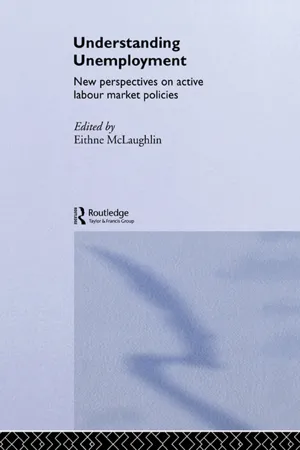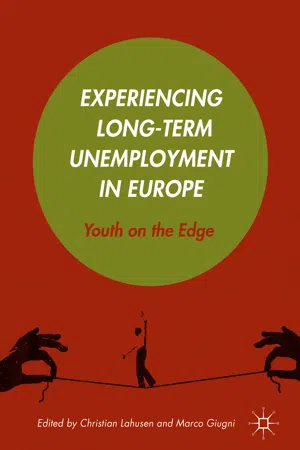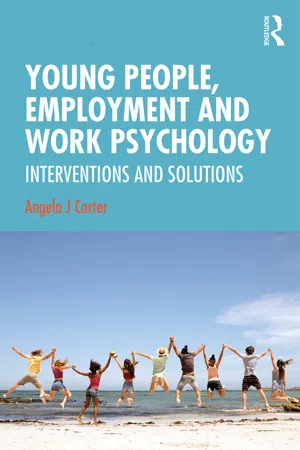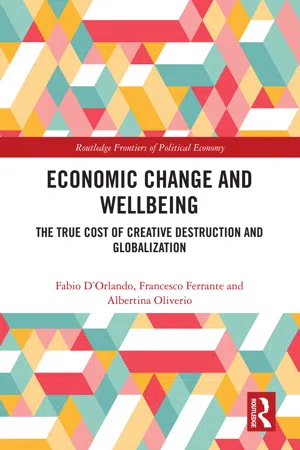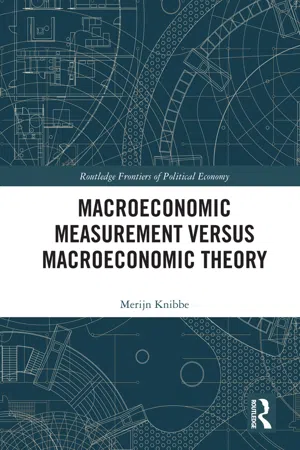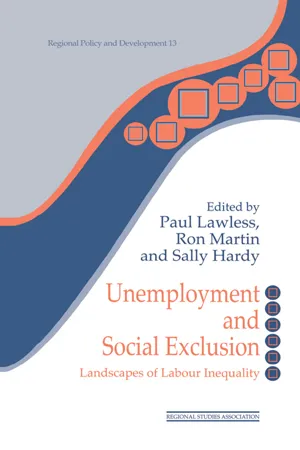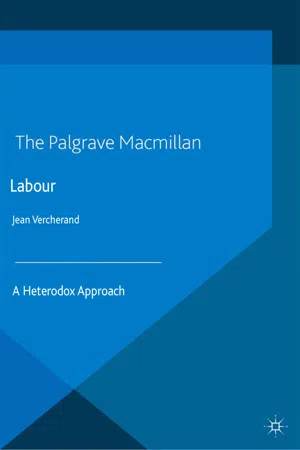Consequences of Unemployment
Unemployment has significant consequences, including reduced consumer spending, lower tax revenues, and increased government spending on social welfare programs. It can also lead to social and psychological issues, such as increased stress, depression, and a sense of hopelessness. Additionally, long-term unemployment can result in skill depreciation and reduced future earning potential.
8 Key excerpts on "Consequences of Unemployment"
- eBook - ePub
Understanding Unemployment
New Perspectives on Active Labour Market Policies
- Eithne Mclaughlin, Eithne Mclaughlin(Authors)
- 2013(Publication Date)
- Routledge(Publisher)
...6 Psychological Or Material Deprivation: Why Does Unemployment Have Mental Health Consequences? David Fryer 1 DOI: 10.4324/9780203061459-6 Introduction It is increasingly accepted that the mental health of the majority of unemployed people suffers. Inferences about the importance of employment as a major social institution through which many people, in contemporary industrialized nations such as our own, meet fundamental psychological needs are frequently drawn. Research from the 1930s to the present day has demonstrated that the psychological Consequences of Unemployment include impaired psychological well-being, anxiety, depression, reduced self-confidence, social isolation and reduced levels of activity. Some interpreters of this literature appear to have reached the conclusion, actually unsupported by empirical evidence (see below), that unemployment significantly reduces people's will to rejoin the world of paid work. In particular, during the 1980s UK government concern about unemployment, and the measures appropriate to deal with it, appears to have been heavily oriented towards remotivation programmes combined with increasingly harsh benefit regimes (see Oppenheim 1990:66). The apparent assumption is that long-term unemployment is primarily a problem of discouraged, demotivated, quasi-voluntarily, unemployed workers with overambitious expectations of their labour market opportunities. It is the purpose of this chapter to review the evidence relating to the psychological Consequences of Unemployment and in particular to critically address the question: are the documented mental health and behaviourial effects of unemployment primarily due to psychological deprivation (that is removal of psychologically supportive aspects of the social relationship of employment) or are they primarily due to material deprivation (that is relative poverty and its social psychological sequelae)...
- eBook - ePub
American Promise
Equal Justice and Economic Opportunity
- Arthur I. Blaustein, Arthur I. Blaustein(Authors)
- 2017(Publication Date)
- Routledge(Publisher)
...This problem has increased significantly as inflation has reduced the standard of living of many American families—especially those with low or moderate incomes to begin with. 198 Conclusion The Council’s research indicates that, despite programs to cushion it, unemployment remains an extremely traumatic and often crippling experience. It has costly consequences, not only for the unemployed but also for their families. The changes in benefits available to the unemployed have not eliminated— although they have mitigated—the adverse impact of unemployment on economic well-being, mental and physical health, family stability and criminal behavior. Unemployment is still a potential catastrophe for individuals and families, and a source of expensive social disruptions for the country as a whole. Economic stability is one of the most important means of achieving what is often called “primary prevention,” or stalling social and personal pathology before it occurs. The Council seriously questions the conventional wisdom that trade-offs between inflation and unemployment are merely issues of economic significance. Economists deal in quantitative theory, and behavioral scientists document the behavior of “deviants.” After gathering the research of the social and human costs of unemployment, the Council finds it impossible to countenance the bland use of statistics and symbolic logic to mask human suffering. The Council cannot merely accept the cost/benefit approach to human suffering when the consequences are unevenly distributed, bearing most heavily on those who can least afford them. Moreover, the Council questions the validity of using cost/benefit analysis without also considering the cost to society of mental illness, crime, drug addiction, child abuse, and divorce...
- eBook - ePub
Experiencing Long-Term Unemployment in Europe
Youth on the Edge
- Christian Lahusen, Marco Giugni, Christian Lahusen, Marco Giugni(Authors)
- 2016(Publication Date)
- Palgrave Macmillan(Publisher)
...In some of the conversations we find references to a generational experience that distances the young unemployed from their parents. Expectations voiced within their families and the public domain are still tied to a labor market that builds on full-time and life-long employment. Our respondents feel unrightfully criticized, given the fact that today’s situation is marked by liberalization, flexibilization and precariousness, thus exposing them to constraints and limitation unprecedented until now. Policy Implications Scholarly work often has relevant policy implications. This is certainly true for research on unemployment, and the analyses presented in this book are no exception. We would like to spell out four such implications, which are more or less directly related to the findings presented in the previous chapters. Firstly, the chapters in this book have shown that long-term unemployment and its consequences on the personal lives of those struck by it continue to be a pressing topic requiring a rapid and effective response from the actors concerned. This is all the most true as the problem affects a particularly vulnerable group, namely young adults. Long-term unemployment generates scarring effects which will affect young people throughout their life-course. Exposure to unemployment among school leavers increase the risks of being unemployed in the future (Cockx and Picchio 2013 ; Gregg 2001), suffering from mental health problems at later stages of their lives (Hammer 2000 ; Strandh et al. 2014) and running into problems of old-age poverty because of limited pension entitlements (Esping-Andersen 1996). There is a risk, which is perhaps already a reality, of generating a ‘lost generation’...
- eBook - ePub
Young People, Employment and Work Psychology
Interventions and Solutions
- Angela Carter(Author)
- 2019(Publication Date)
- Routledge(Publisher)
...Theoretically there are several ways to explain this different effect: adolescents might have had fewer opportunities to benefit from the well-being-enhancing experiences of employment (simply due to having had less work experience), and adolescents might have fewer alternative activity sources to compensate for unemployment (e.g., by caring and family duties, volunteer work). In addition, adolescents have to deal with hormonal and developmental challenges along with the stress of achieving central life goals, which might create additional strain to which middle-aged people might not be exposed in that form. This implies that in order to support young adolescents who are not in employment, education or training it may not be enough to solely look at the factors that lead them into this situation, but also to regard the negative aspects specific to the experience itself. Psychological Consequences of Unemployment at a young age The long-term consequences of youth unemployment are well established, as unemployment seems to predict future unemployment. People who have been unemployed in their lives have a higher risk of becoming unemployed in the future. Longitudinal studies show that adolescents who experienced longer spells of unemployment experience a wage penalty in the form of lower life-time earnings than those who spend the same period in education or training (Mroz & Savage, 2006). The period of being not in employment, education or training hence leads to a ‘scarring’ effect on a young person’s career that is visible over a longer period of time (OECD, 2010). Furthermore, adolescent unemployment is presumed to be a risk factor for future social exclusion (Kieselbach, 2003; Sen, 2000). How can these longitudinal effects be explained? On a psychological level, unemployment, not being in education or failing a life goal will have a variety of effects. These effects are likely to impact on an adolescent’s choices, behaviours and future chances to succeed...
- eBook - ePub
Economic Change and Wellbeing
The True Cost of Creative Destruction and Globalization
- Fabio D'Orlando, Francesco Ferrante, Albertina Oliverio(Authors)
- 2021(Publication Date)
- Routledge(Publisher)
...Not surprisingly, they are a major source of regret in people’s lives (Ferrante 2009). Macroeconomic instability is another potential major source of educational and skill mismatches bearing long-term negative consequences. Negative macroeconomic shocks may exert permanent effects on young workers entering the labor market during downturns. There is strong evidence that mismatched young workers experience persistently worse employment conditions in terms of wages. In particular, the costs borne by young workers entering the labor markets for the first time can be very high even when they find a job. With bad labor market conditions skills matching will be less efficient and this initial poor-quality relationship between young workers and employers will produce long-lasting adverse effects on wages and career prospects. Some estimates for university graduates in the USA suggest that these effects may last up to 20 years and that they may imply a 20% total wage penalty compared with the luckier colleagues who entered in favorable times (Liu, Salvanes and Sorensen 2012; Oreopoulos, Wachter and Heisz 2012). This loss is regressive in that it has a greater effect on young workers from disadvantaged social backgrounds who cannot wait long for the right job and who cannot postpone labor market entry by investing in more education. 1.3 Other consequences Apart from the consequences for the labor market, the process of creative destruction has impacted other aspects of the economy and society. In particular, in what follows we focus on increasing inequality, diverging trends in social mobility, and the spread of populism and protectionism. 1.3.1 Rising inequality and diverging trends in social mobility The consequences of economic change for the workers and the general wellbeing depend not only on their wages but also on the availability of institutional arrangements to support those losing out and redistribute the gains of economic change...
- Merijn Knibbe(Author)
- 2019(Publication Date)
- Routledge(Publisher)
...If somebody is having no work and can and will work but is not actively seeking, he or she will add to ‘broad unemployment’ but not to ‘headline’ unemployment (see Graph 4.3). Alas, the lack of true understanding of Lucas and his associates about what the unemployment rate measures seems to be an inherent characteristic of academic economics. Card (2011) shows that academic economists played next to no role in the development of the concept op measured unemployment – which also explains the problems Keynes mention in the second chapter of the general theory with finding a consistent statement of the nature of unemployment in the work of academic economists. But this is of course no excuse to equate unemployment with leisure. There is momentous literature about ‘scarring’ which indicates that people, when fired, have on average lower incomes for many years and possibly even decades after been fired. Even when they quickly find a new job. ‘Closing early on low price days’, aka becoming unemployed, is in a wage labor economy not compensated by high price days. There also is a momentous literature which shows that unemployed people are unhappy and often even depressed while time does not heal this wound. There is no difference in this between the short-term and the long-term unemployed. The unemployed do not enjoy unemployment. It’s not leisure. It was bad luck for Lucas that just before his statement appeared in print broad US unemployment as well as normal US unemployment rapidly increased to the highest post-war level thus far and stayed elevated for decades to come, a pattern consistent with Hendry and Mizon (2014) and ideas about the involuntary nature of much unemployment, which are consistent with the findings of Mathy (2018) who shows that the long-term unemployed have much more trouble than the short-term unemployed to find a job again. Once people are long-term unemployed they rapidly become less employable...
- eBook - ePub
Unemployment and Social Exclusion
Landscapes of Labour inequality and Social Exclusion
- Sally Hardy, Paul Lawless, Ron Martin, Sally Hardy, Paul Lawless, Ron Martin(Authors)
- 2013(Publication Date)
- Routledge(Publisher)
...Specialisation and division of labour tend to make employment more unstable, more precarious of tenure and less certain in market value. The effects are not obvious in an economy where new employment broadly compensates for, and matches, jobs lost. But they create real problems when employment decline leaves large numbers of workers without effective labour market opportunity. Innovation and structural change – the compensatory ‘gale of creative destruction’ – does not merely check existing developments, it puts an end to them. The employment relationships that dissolve involve external economies. Different kinds of unemployment interact and build from each other, and the loss of a locality’s economic base has implications for employment in the local service sector. What might have been frictional unemployment (requiring little change and limited search by potential employees) becomes structural unemployment (possibly requiring extensive labour retraining and changes in occupation, industry and/or location), and what may have been structural unemployment translates into extended unemployment or even withdrawal from the labour force altogether. Unemployment, in the Keynesian view, is associated with loss of markets and a lack of effective demand. Effective demand depends on a host of economic decisions, both private and public, and especially on investment. Since this in turn depends on demand for particular products and services in a future which cannot be known, there are limits to markets and to market signals. The Keynesian and post-Keynesian claim is that wages (and other) prices are less flexible and less effective in clearing markets than the counter-revolution suggests. Wages (and more generally prices) are not as sensitive as market-clearing implies and when wages are flexible, falls in money wages do not necessarily lead to falls in real wages and these do not necessarily stimulate new employment...
- eBook - ePub
Labour
A Heterodox Approach
- Jean Vercherand(Author)
- 2014(Publication Date)
- Palgrave Macmillan(Publisher)
...This chapter also permitted interpreting the observation made by historians of the very irregular distribution of gains in productivity over two centuries between increased wages and reduced working time, to such an extent that in certain periods the effective duration of working time was seen to increase. We showed that the origin of these occurrences lay in the twofold impact of technical progress: on the one hand, it contributed to increasing productivity factors (particularly of labour); on the other, it contributed to increasing the propensity to consume (by the innovations it implemented in the consumer goods sector) and thus stimulating consumption by households. Also, there is no reason why the two dynamics should be equal over the long-term. The result is that two categories of unemployment emerge (excluding “natural” unemployment linked to imperfect professional and geographic mobility): • Short-term unemployment linked to discordant evolutions, profits and wages, ending in crises of overproduction (or overinvestment). The latter develop when the wage rate is not adjusted or indexed to the (net) maximum average added value of labour. 1 • Long-term unemployment linked to discordant evolutions, labour productivity and consumption (or global demand); the dynamics of the latter being weaker than that of the former, whereas the legal duration of work remains unchanged. Let us examine the policies that could be implemented to combat this unemployment. 1 The combat against unemployment It is out of the question to attempt an exhaustive analysis here; we limit discussion to a schematic view by situating our reasoning in line with the theories developed previously. 1.1 Short-term unemployment 1.1.1 Prevention Unemployment can be prevented by adjusting the wage rate with the maximum average (net) added value of labour (such that companies do not generate any surplus profit) and then by indexing this rate to productivity gains (cf. Ch...
